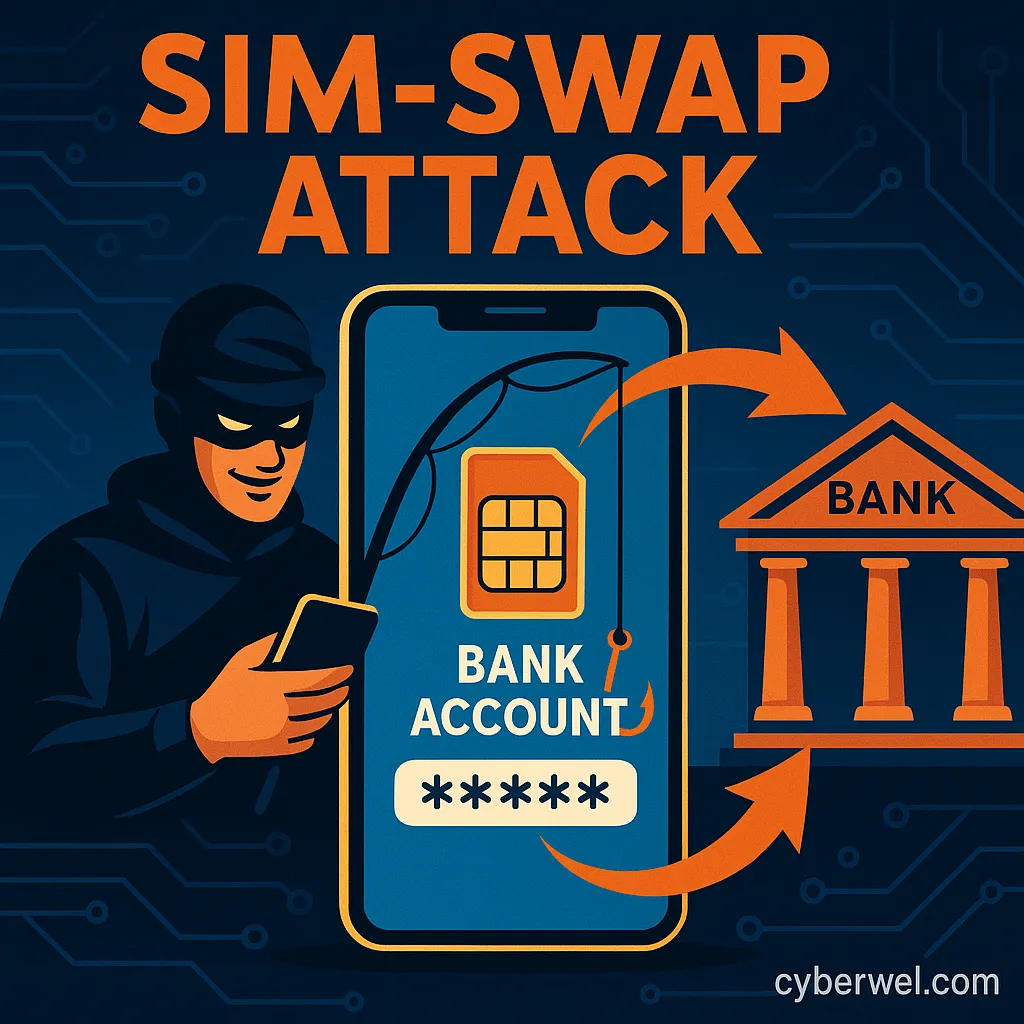⚠️ Disclaimer
This article is strictly educational and promotes ethical cybersecurity awareness. It does not promote or condone any illegal activity. All content complies with applicable laws and is intended solely for informational purposes.
📞 Prologue: The SIM Whisperer
“I didn’t need to break into a bank,” said an anonymous hacker interviewed on an underground forum. “I just made a phone call.”
With that call, the hacker convinced a mobile carrier to assign a new SIM card to someone else’s number. Within 30 minutes, they drained thousands from checking and crypto accounts, intercepted 2FA codes, and took over Gmail, PayPal, and Coinbase — all from a prepaid phone and a borrowed voice.
This is not theoretical. It’s happening every day. And unless you’re protected, you might be next.
🔓 What Is a SIM-Swap Attack?
SIM swapping — also called SIM hijacking — is a type of identity theft that targets the weakest link in your digital chain: your phone number.
By impersonating you, bribing a mobile carrier employee, or exploiting internal tools, attackers reroute your number to a SIM card they control.
Once that’s done, they receive your:
- SMS codes
- Calls
- Password reset links
It’s like giving a thief your house keys, alarm code, and mailbox access all at once.
🎯 Key Targets:
- Bank accounts
- Email and cloud storage
- Crypto wallets
- Social media (for blackmail or reputation damage)
🧠 Anatomy of an Attack: Step-by-Step
📥 1. Data Harvesting
Attackers collect public and leaked data: full name, number, birthday, email, address. Social media is often a goldmine.
🎭 2. Social Engineering
They call your mobile provider, impersonating you. Or they bribe a low-level employee for access.
“$100 is all it takes for someone to give me your number,” said a former SIM-swapper to Motherboard.
🔁 3. SIM Swap Executed
Your real SIM stops working. The attacker now controls your number.
🔐 4. Account Takeover Begins
They trigger SMS password resets on your bank, Gmail, and crypto exchange. Within minutes, they’re inside your digital vault.
📊 Infographic: Timeline of a SIM-Swap Attack
| Step | Time Elapsed | Attacker’s Action |
|---|---|---|
| 1 | 0 mins | Recon: gathers personal data |
| 2 | +10 mins | Calls carrier, initiates SIM swap |
| 3 | +15 mins | New SIM activated, old one deactivated |
| 4 | +20 mins | Triggers password resets |
| 5 | +30 mins | Gains access to bank, email, crypto |
🔥 Notable Cases
- T-Mobile (2022): Paid $350 million in settlement after data leaks and SIM-swap frauds.
- Michael Terpin: Crypto investor who lost $24 million in a single SIM-swap.
- Jack Dorsey (2019): Former Twitter CEO’s account was hijacked via SIM-swap.
SIM hijacking is no longer fringe cybercrime — it’s mainstream and profitable.
🛠️ How to Defend Yourself (Now and Long-Term)
✅ 1. Remove SMS-Based 2FA from Critical Accounts
Instead, use:
- Authenticator apps (Google Authenticator, Authy)
- Hardware tokens (YubiKey, Titan)
“If your bank only offers SMS for 2FA, switch banks.” — Eva Galperin, EFF
✅ 2. Use Secret, Unlinked Emails for Finance
Create unique, private emails for:
- Banking
- Crypto
- PayPal
Avoid connecting them to any social media.
✅ 3. Add a Carrier-Level PIN or Passcode
Call your carrier and request a port-out PIN or account lock. Some providers hide this feature — be persistent.
✅ 4. Monitor and Lock Your Credit and Mobile Access
- Use HaveIBeenPwned to monitor breaches
- Ask your carrier for porting alerts
- Freeze your credit reports (Equifax, TransUnion, Experian)
✅ 5. Set Up Alerts and Log Audits
Enable notifications for:
- Unusual logins
- Password reset attempts
- Recovery setting changes
🛡️ Expert-Level Protections
| Technique | Description |
| Split Identity Model | Use different emails and numbers across platforms |
| VoIP for Low-Value Use | Use Google Voice for shopping/subscription services |
| Security Keys | Physical token required to log in (e.g. YubiKey) |
| Numberless Bank Cards | Use fintech tools that hide your real card/phone number |
🧭 Visual Flow: How SIM-Swap Leads to Bank Theft
- SIM Cloned → 2. Phone Access → 3. 2FA Hijacked → 4. Password Reset → 5. Bank Account Breached
🧠 Why SIM-Based 2FA Still Exists (and Why It’s a Problem)
Even in 2025, many banks, financial apps, and government platforms still rely on SMS as a form of two-factor authentication (2FA). Why? Because it’s easy to implement, familiar to users, and doesn’t require them to download anything new or purchase additional hardware.
But this convenience is also its greatest vulnerability.
Unlike app-based authentication or security keys, SMS messages:
- Can be intercepted or rerouted via SIM swap
- Are transmitted unencrypted over mobile networks
- Can be spoofed by attackers using simple tools
“The problem isn’t just the attackers,” says cybersecurity analyst Marcus Zhou. “It’s that major institutions still treat SMS as secure when it was never designed for that.”
In other words, even if you follow best practices, your accounts may remain exposed if the service provider fails to move away from outdated 2FA methods. That’s why eliminating SMS-based authentication from your most sensitive accounts is one of the most important steps you can take.

🌐 Global SIM-Swap Risk Map: Who’s Most Vulnerable?
While SIM-swap fraud is a global problem, the level of risk varies by region due to differences in telecom regulations, financial infrastructure, and user behavior.
| Region | Risk Level | Why |
| United States | 🔴 High | Weak ID verification, fragmented telecom systems |
| Latin America | 🔴 High | Widespread use of SMS for financial authentication |
| Western Europe | 🟡 Medium | Some countries enforce strict porting rules, others less |
| Russia & CIS | 🟡 Medium | Mixed adoption of secure methods, legacy platforms |
| Kazakhstan | 🟡 Medium | Improvements underway, but SMS still common in banking |
| East Asia | 🟢 Lower | Advanced use of biometric and app-based verification |
“SIM-swapping thrives where telecoms are weak and convenience is prioritized over security.”
The takeaway? Even in regions with tighter telecom controls, attackers look for human errors, social engineering gaps, and unsecured services. No country is immune — your personal security posture matters more than your geography.
🧠 Glossary
- SIM (Subscriber Identity Module): Chip that links your phone to your number.
- 2FA (Two-Factor Authentication): Two separate credentials to confirm identity.
- Porting: Transferring your number to a new SIM or carrier.
- Social Engineering: Manipulation to trick people into revealing confidential info.
🙋 FAQ
Q: Can I still use SMS-based 2FA?
A: Only as a last resort. Use authenticator apps or security keys for stronger protection.
Q: What if my SIM is already swapped?
A: Call your carrier immediately, lock your accounts, reset all passwords, and alert your banks.
Q: Will prepaid SIMs protect me?
A: Not necessarily. What matters is your carrier’s account security, not the SIM type.
✅ Conclusion: Lock the Digital Door
Your phone number isn’t just digits — it’s your digital keychain.
SIM-swap attackers know it — and now you do too.
You can’t control your telecom provider’s security. But you can control how much damage your number can cause:
- Remove SMS from key accounts.
- Lock your SIM with a port-out PIN.
- Treat your number like a vault key, not a convenience.
Because in 2025, a stolen signal is all it takes to steal your savings.
